This study focuses on Kurdish female journalists’ experiences and tactics in a male- dominated world. The study uses gender (concept) and doxa (field theory) to analyze the experiences and tactics that Kurdish female journalists use to navigate their professional practice. In the study, qualitative method is used in the form of semi-structured interviews. Ten Kurdish female journalists that worked for different tv-stations and newspaper were interviewed. The study resulted in six different themes that describe respondents’ experiences and tactics: The impact of digitalization, challenges, reporting of hard and soft news, glass roofs, and unwritten rules. Many of the results confirmed previous research regarding the challenges and tactics, but there were also differences. For example, the respondents reported no wage of discrimination. Moreover, they did not report that Kurdish female journalists would use freelancing as a tactic to navigate the male dominated world.
Kategoriarkiv: Journalistikgranskning
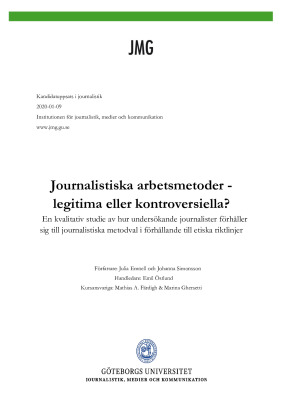
Journalistiska arbetsmetoder – legitima eller kontroversiella?
Purpose: The main purpose of the study is to examine how investigative journalists motivate and legitimize their method choices in relation to professional ethical rules. The study has a qualitative approach and central to the empirical material from interviews with journalists. The study is aimed at both the public and journalists.
Method: Qualitative in-depth interviews with swedish investigative journalist.
Procedure: Eight interviews with investigative journalists were transcribed and analyzed using the theory of consequence neutrality and the social responsibility theory. Previous research on journalism’s socialbenefits and controversial methods was also used among others to analyze the empiricism in the study.
Results: The results of the study show that the journalists in the study believe that it is of the utmost importance to explain why certain methods are used. That careful consideration must always be made and that one can clearly justify journalistic method choices. By doing this, journalists can also legitimize the method choices. All journalists believe that method choice is a major responsibility for maintaining journalism, and it can therefore be concluded that investigative journalists must always to some extent consider the consequences of
whether individuals can be subjected to exposure after a publication. Thus, it is an extremely difficult balancing act investigative journalists face when it comes to considering people’s integrity and fulfilling the primary mission of investigative journalism: to examine power.
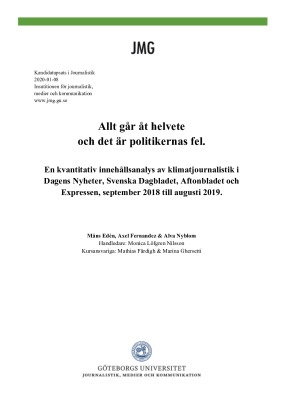
Allt går åt helvete och det är politikernas fel.
The aim of this study is to examine how climate change is framed in Swedish climate reporting, published on the website of national newspapers – Dagens Nyheter, Svenska Dagbladet, Aftonbladet and Expressen – from September 2018 throughout August 2019. Through a quantitative content study regarding climate change published online in chosen newspapers, the goal is to map out how Swedish newspapers use frames – consciously or not – to affect the public.
Through a perspective of the framing theory – invented and coined by Erving Goffman in the 1970’s – questions about frames are asked while reading chosen articles on climate change, to see which frames are most prominent. From previous scientific studies, it is suggested that certain frames in the news-media has certain effects on the readers. This study may hopefully contribute to the debate on how news in media are affecting the view on the climate change in Sweden.
The findings of the study show that the structural responsibility frame was the one frame used the most throughout all four newspapers, even though the outcome frame was the most common category. While found in 54 percent of all articles studied, the structural responsibility frame also tended to be dominant in most of these cases. While the loss frame was less common than the structural responsibility frame, it was dominant in the same amount of articles. The frame least used was the system critical frame, as it only appeared in 3,4 percent of the articles. As for sources, the one most used by all newspapers was academic/expert, in 27,8 percent of the articles, while sceptics were the least asked, 0,4 percent. The study also shows that the overall prominence of each frame was quite similar between the newspapers, with a few exceptions. The structural responsibility frame was the most common in all newspapers, with Expressen as exception, with the loss frame as most common. The loss frame was present in all papers, but was least prominent in Dagens Nyheter. The system critical frame was the least found frame in all papers, except in Aftonbladet, where the moral frame was the least prominent. No systematic differences between morning- and evening papers were found.

Hur går det för lokaljournalistiken?
In the big city regions in Sweden, with their growing populations, the local newspapers have a large number of municipalities to cover and do not have the same space for every municipality as in local newspapers in other parts of Sweden. Previous studies have shown that many municipalities located within commuting distance from the big cities are covered by local newspapers and public service media as well as hyperlocal media, such as free weeklies and local news sites. Hyperlocal media are more local than local newspapers and public service media, but the question is what hyperlocal media can contribute with in relation to the content in other media covering these municipalities.
Thus the aim of this thesis is to study the local coverage of two municipalities outside of Malmö, Burlöv and Vellinge, and to discuss to which extent hyperlocal media are a complement to local and regional media. The focus lies on the coverage in hyperlocal media compared to local and regional media as well as the differences between the coverage of the two municipalities. In the analysis we have related our results to theories on the role of media in democracy, media ecology and the commercialization of media.
The study is based on a quantitative content analysis of the total news coverage mentioning either of the two municipalities during eight weeks spread out over 2019. For every article we have looked at the subject, the actors that get to express themselves, credit given to other media sources and the distribution of news versus opinion material.
The main findings of this study are that the majority of the articles were in one of the two local newspapers and that 39 per cent of the articles were in one of the four hyperlocal media outlets. The subjects culture/leisure and trade/industry were more common in the hyperlocal media outlets and crime was more common in the local and regional media outlets. Regarding the actors, the civil sphere was more common in the hyperlocal media outlets whereas the political, bureaucratic and legal spheres were more common in local and regional media. These differences in subjects and actors show that the hyperlocal media do to some extent complement the local and regional media. We also found that there were three times as many articles about Vellinge as about Burlöv. The articles about Vellinge were more often about sport and the articles about Burlöv were more often about crime. The actors corresponding to those subjects were also more common in the corresponding municipality.
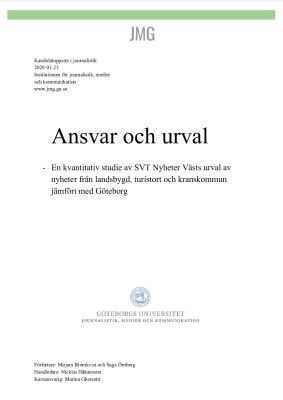
Ansvar och urval
This study is an analysis of SVT Nyheter Väst ́s news selection. Previous research shows that the media coverage in Sweden is becoming more concentrated to bigger cities. As a result, smaller municipalities and the countryside risk to suffer the consequences of insufficient information about their own community. The concentration to big cities in media is due mostly to harsh economic conditions. A pinched economic situation forces rationalization, leading to fewer journalists in each editorial office. That in turn leads to less possibilities and interest of writing and publishing news that are related to places outside of big cities.
SVT is one of three public service companies in Sweden and have a particular responsibility compared to commercial news media. The alignment of the content is that public service media are obligated to provide citizens with enough information about their society to enable political engagement. Therefore, public service media such as SVT Nyheter serves a key role in a democratic society. A coverage that is to narrow and excludes certain geographic areas could implicate that such ideals are not lived up to. Therefore we have decided to look into one of SVT ́s local editorials to find out how their coverage relates to Gothenburg, surrounding municipalities, the countryside and tourist resorts within the county of Västra Götaland.
The main aim of this study is to examine what type of news that are published from different kind of areas (municipalities around Gothenburg, countryside municipalities, and small municipalities with tourist industries) outside Gothenburg. We also intend to map out how the proportion of news is distributed between these areas and Gothenburg, and how they are distributed on different publishing platforms. We have chosen to do a quantitative content analysis of a total of 105 publications during five days. The platforms that has been investigated are SVT Nyheter Väst ́s Facebook, web site and local television broadcasts. The study is based in theories of news value and the public service assignment.
A few of the most significant results of the study is the frequency of subjects in different channels. In our result we could see that news about politics were more common on the web site and in local television broadcast. Another interesting result was that news distributed on Facebook more oftenly were based on big city actualities. That can be due to the fact that younger people and big city residents consume news on social media more than other groups in society. Another significant result was that 40 percent of the news came from Gothenburg. 20 percent of the news came from the municipalities around Gothenburg, the countryside municipalities and the municipalities with tourist industries. The final results showed that the most common article for these five days came from Gothenburg, was about crimes and published on the website.
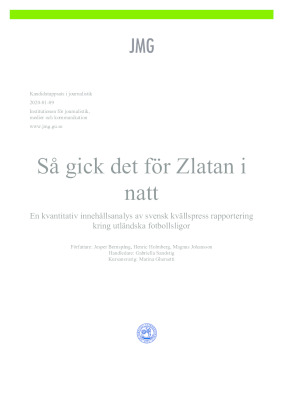
Så gick det för Zlatan i natt
Aim of thesis: The study aims to investigate in which extent Swedish media reporting around foreign football leagues is person-oriented in general and around Swedish players in particular. To achieve this, theories and research about news valuation, media logic, ethnocentrism and National Sporting Heroes will be implemented.
The purpose will be achieved by coding articles from Swedish tabloids (Aftonbladet and Expressen) from four international football leagues (the English Premier League, the Italian Serie A, the Danish Superligaen and the American Major League Soccer) during three different seasons: 1998/1999, 2008/2009 and 2018/2019.
Theoretical framework: This study relies on a number of different theories, although the main one is person-orientation. Other important theories are news valuation, media logic, ethnocentrism and National Sporting Heroes. The study takes off in Ulf Wallin’s Sporten i spalterna from 1998 and Strömgren and Strandlund’s Sportens nyhetsvärdering i kvällspress from 2009.
Methods(s): The study uses quantitative content analysis as method. The number of examined articles are 1182. These were examined with the help of a coding scheme consisting of 16 different variables.
Results: The main result from the study is that 98 percent of all the examined articles were more or less person-oriented. That shows an increase compared to Wallin’s study from 1998 and Strömgren and Strandlund’s study from 2009. Another important result is that a Swedish person (players and non-players combined) is mentioned in 51 percent of all the articles. In addition, 92 percent of all the articles, where a swedish player is the main actor, is either fully or mainly person-oriented.
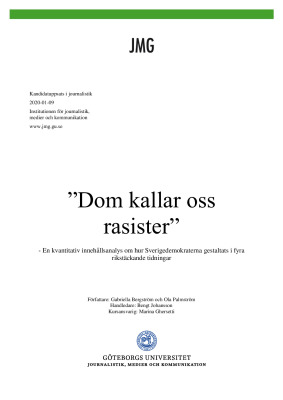
”Dom kallar oss rasister”
Aim of thesis: The purpose of this study is to examine and analyze how the Populist Party the Swedish Democrats have been described in news media before the general elections of 2010, 2014 and 2018. We are also interested to see if the descriptions have changed over time.
The aim is not to see how much they have been covered in the news. Nor if the news coverage has been positive or negative, but with which words and qualities they have been characterized. Words are not just words. Specific words can say something about thought patterns and feelings. By looking at words you may be able to draw conclusions of a bigger picture.
We are also investigating if there are any differences in the news coverage between morning papers, such as Svenska Dagbladet and Dagens Nyheter, and evening papers, Aftonbladet and Expressen.
Theoretical framework: Since one of our study’s main purposes is to systematize specific words we are using the framing theory with a linguistic approach.
Methods: We are using a quantitative content analysis, a method that is well suitable when you have a big amount of data. It is commonly used when the analysis procedure consists of quantifying
or measuring the incidence of something in a text. In our case, words in articles.
Results: Our results show that the most common frames are “racism”, “nazism/fascism” and “immigration”. In total they make out fifty percent of all the frames. It also shows that the negative descriptions of the party do not change over time, but the way of saying them does. In 2010 more of the descriptions came directly from the journalist and were critical of their present politics. Before the general election of 2018 the journalist quoted others in a larger range and the criticism of The Swedish Democrats was addressed to their history and ideology rather than their politics. Due to this, the immigration frame decreased immensely in 2018 while “nazism/fascism” became the most commonly used frame.
Fria Tider och Samtiden
On the 13 of April 2019, the Swedish evening newspapers, Expressen published an article on the refugee situation of Filipstad. The small municipality had received a large number of refugees compared to its size. The chairman of the municipal council was cited that the economy was strained, the unemployment numbers were high, and the municipality was applying for bankruptcy.
The medial effect was immediate, and several newspapers, television and radio channels reported on the subject. Also, two alternative media, the Fria Tider and Samtiden published several articles on the situation.
There is a lack of research on the far-right alternative media in the Swedish context and especially how they frame their news. There is little or limited knowledge about the two far-right alternative medias the Fria Tider and the Samtiden. And as a result of comparing two different far-right alternative media this essay aims to broaden the research of two of the main far right alternative media in the Swedish context. Therefore, this essay aims to investigate how the Fria Tider and the Samtiden framed the story regarding to “the situation in Filipstad”
The method used in this study was a systematic text analysis comparing seven articles from the Fria Tider (3) and Samtiden (4) and how they framed the situation in Filipstad. The framing theories of Dennis Chong and James Druckman was used, as was the theory about far-right alternative media by Kristoffer Holt.
The analysis revealed that the Fria Tider framed the situation in Filipstad as a direct effect of immigrants related to their skills, while the Samtiden framed the situation as a result of migration policy and bad municipality decisions.
Conclusively, the analysis revealed that the Fria Tider and Samtiden framed the “situation in Filipstad” differently where Samtiden resemble how the traditional media framed the news and the Fria Tider is a polarizing/anti system alternative media.
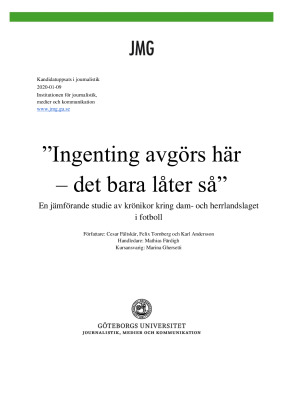
”Ingenting avgörs här – det bara låter så”
Aim of thesis: Our essay is aiming towards an understanding of the Swedish media coverage of the Swedish men’s and women’s national football team. We want to reach a conclusion on whether or not the four largest sports editorials are treating the two national teams any different in their reporting, focusing on columns. Another ambition is to compare Swedish evening and morning papers, and to see if there is any difference in their reporting around the national teams.
Theoretical framework: We have gathered various theoretical thesis – such as intersectionality, female and masculine attributes and hegemony, and have created a codebook to help us gather information around all the columns that we have coded.
Method(s): Our codebook consists of 20 variables. We decided to code all columns written by the largest sports editorials in Sweden – Aftonbladet, Expressen, Dagens Nyheter and Göteborgs-Posten. In total, it added up to 135 columns written by ten columnists. 81 columns were written in conjunction with the FIFA World Cup 2018 for men, and 54 in conjunction with the FIFA World Cup 2019 for women.
Results: The results were interesting. For example, we found out that gender was mentioned in around 50 percent of the columns regarding the World Cup for women, but only in 15 percent of the columns regarding the World Cup for men.
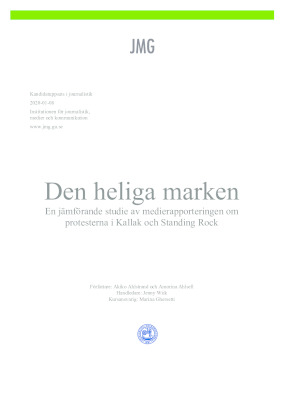
Den heliga marken
This study examines how two protests were portrayed in the Swedish news media; the protest of indigenous people against a mine in Kallak, in the region of Norrland in Sweden, compared with the protest of indigenous people against a pipeline in Standing Rock, North Dakota in the U.S. The purpose is to investigate if there are any differences linked to the Swedish newspapers relation to their own national identity.
To be able to find differences in the coverage this study follows three main lines of enquiry: What is the problem represented to be in Kallak vs Standing Rock? Does the media logic interact with other power structures in the coverage of Kallak vs Standing Rock? Does the coverage reproduce or dispute any power structures?
The conflicts are similar in each case since both are about land issues and its cultural and environmental importance for the indigenous people. Furthermore both conflicts include the same main actors; the protesters, the government, the police and the company behind the mine/pipeline. The study therefore argues that the protests are comparable.
The study adopts a theoretical framework informed by post-colonial theory, media logic and critical discourse analysis, and the empirical study was also approached through critical discourse analysis. The material consisted of 12 articles from four of the largest nationwide newspapers in Sweden; Aftonbladet, Dagens nyheter, Expressen and Svenska Dagbladet. The results show that the conflicts are lifted to very different political levels. In Kallak the conflict is presented as local, with few connections to decision-makers. Here the responsible part was largely portrayed as being the companies. In Standing Rock on the other hand there was a specific focus on the presidents of the U.S who were portrayed as being ultimately responsible. Furthermore, the reporting of Standing Rock linked the protests to a colonial history, which was not done in the reporting of Kallak. The study argues that the results indicate that the national identity of journalists influenced the coverage of these protests. In addition, we argue that the media logic plays a big part in the result, especially through simplification.
